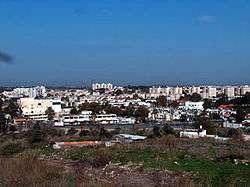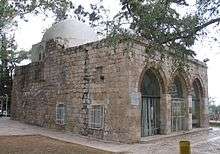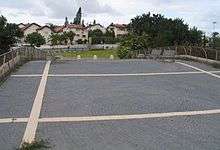Yavne
Yavne
| ||
|---|---|---|
| Hebrew transcription(s) | ||
| • ISO 259 | Yabne | |
 | ||
| ||
 Yavne | ||
| Coordinates: 31°53′N 34°44′E / 31.883°N 34.733°ECoordinates: 31°53′N 34°44′E / 31.883°N 34.733°E | ||
| Founded |
Bronze Age (ancient city) 1941 (Kibbutz Yavne) 1949 (City of Yavne) | |
| Government | ||
| • Type | City | |
| • Mayor | Zvi Gov-Ari | |
| Area | ||
| • Total | 10,700 dunams (10.7 km2 or 4.1 sq mi) | |
| Population (2015)[1] | ||
| • Total | 42,314 | |
Yavne (Hebrew: יַבְנֶה), historically also known as Jabneh or Jamnia, is a city in the Central District of Israel. In 2015 it had a population of 42,314.
History

Yavne was one of the major ancient cities in the southern coastal plain, situated 20 km (12.43 mi) south of Jaffa, 15 km (9.32 mi) north of Ashdod, and 7 km (4.35 mi) east of the Mediterranean.[2]
Excavations were carried out on the ancient tell (mound created by accumulation of archaeological remains) known as Tel Yavne (Hebrew) or Yebna (Arabic), which developed on a natural kurkar hill. The tell was inhabited, possibly continuously, from either the Bronze or Iron Age until the British Mandate period. During some periods, especially the Byzantine period, the settlement expanded to cover part of the plain and hills surrounding the tell.[2][3][4][5] Yavneh is mentioned in the Hebrew Bible and it is documented in written sources and through archaeological excavations on the main tell and the adjacent "Temple Hill" throughout the ages.[3][5]
Bronze and Iron Age
Tel Yavne
Salvage excavations carried out in 2001 by the Israel Antiquities Authority uncovered several burials at the northern foot of the original tell. Most of the burials are dated to the later Iron Age. One burial points to a late Bronze Age occupation.
A large Philistine favissa (deposit of cultic artifacts) was discovered on Temple Hill.[3] Two excavation seasons in the 2000s led by Professor Dan Bahat revealed some Iron Age remains. Pottery sherds of the Iron Age and Persian period were discovered at the surface of the tell.[5]
Yavne Yam
The ancient harbour of Jabneh has been identified on the coast at Minet Rubin (Arabic) or Yavne-Yam (Hebrew), where excavations have revealed fortification going back to the Bronze Age Hyksos.[5] It has been in use from the Middle Bronze Age until the 12th century CE, when it was abanodoned.[6]
Herodian and Roman Period
In Roman times, the city was known as Iamnia, also spelled Jamnia. It was bequeathed by King Herod upon his death to his sister Salome. Upon her death it passed to Emperor Augustus, who managed it as a private imperial estate, a status it was to maintain for at least a century.[7] After Salome's death, Iamnia came into the property of Livia, the future Roman empress, and then to her son Tiberius.[8]
Significance for Judaism
Yavneh is considered to be the most significant site for post-biblical Jewish history after Jerusalem, since it was here that modern Judaism was born after the destruction of Jerusalem in the year 70 CE and the loss of the Second Temple, until then the centre of religious identity for the Jews.[4] The process started in Yavneh after 70 CE was essential for adapting Judaism to a new situation where there was no central Temple, in terms of laws, calendar, and liturgy.[4] This became the base for Jewish religious practice throughout the world until today.[4]
After the destruction of the Second Temple in 70 CE, Rabban Yochanan Ben Zakkai moved the Sanhedrin to Yavne. Some scholars believe the so-called Council of Yavne met there. The Sanhedrin left Yavne for Usha in 80 CE and returned in 116 CE.

Byzantine Period
Byzantine period finds from excavations include an aqueduct east of the tell, and a kiln.[9][10]
Early Islamic period
The Islamic historian al-Baladhuri (died 892 CE) mentioned Yibna as one of ten towns in Jund Filastin conquered by the Rashidun army led by 'Amr ibn al-'As in the early 7th century.[11]
In 2007, remains ranging from the Early Islamic period until the British Mandate period were uncovered.[12] An additional kiln, and part of a commercial/industrial area were uncovered at the west of the tell in 2009.[13]
Crusader, Ayyubid and Mamluk Periods
The Crusaders called the city Ibelin and built a castle there in 1141. Two excavation seasons led by Professor Dan Bahat starting in 2005 revealed the main gate. Its namesake noble family, Ibelin, was important in the Kingdom of Jerusalem and later in the Kingdom of Cyprus. Ibelin was captured by Saladin in 1187. Salvage excavations at the west of the tell unearthed a stash of 53 Crusader coins of the 12th and 13th centuries.[13]
Ibelin's parish church was transformed into a mosque, to which a minaret was added during the Mamluk period in 1337. The minaret survives until today, while the mosque (the former Crusader church) was blown up by the IDF in 1950.[3][14]
Maqam Abu Hurayra, described as "one of the finest domed mausoleums in Palestine", is located in Yavne. Since the 12th century, it has been known as a tomb of Abu Hurairah, a companion (sahaba) of the Islamic prophet Muhammad. After 1948 the shrine has been taken over by Sephardic Jews who believe that the tomb is the burial place of Rabbi Gamaliel of Yavne.[15]
Ottoman Period
For the Arab village of Yibna during the Ottoman Period (1517-1917), see Yibna.
British Mandate
In 1941, Kvutzat Yavne was established nearby by refugees from Germany, followed by a Youth Aliyah village, Givat Washington, in 1946.[16]
In mid-March 1948, a contingent of Iraqi soldiers moved into the village of Yibna. In a Haganah reprisal on 30 March, two dozen villagers were killed. On April 21, the Iraqi village commander was arrested in Jaffa for drunkenly shooting two Arabs.[17]
Israel
During the 1948 Arab–Israeli War, residents of Zarnuqa sought refuge in Yibna, but left after the villagers accused them of being traitors.[18]
On 27 May, following the fall of Al-Qubayba and Zarnuqa, most of the population of Yibna fled to Isdud, but armed males were refused entry. On 5 June, when Israeli troops arrived, they found the village almost deserted apart from a few old people who were ordered to leave.[18]
After 1948, a number of Israeli villages were founded on Yibna land: Kfar HaNagid and Beit Gamliel in 1949, Ben Zakai in 1950, Kfar Aviv (originally: "Kfar HaYeor") in 1951, Tzofiyya in 1955.[19] According to Walid Khalidi, a railroad crosses the village. The old mosque and minaret, together with a shrine can still be seen, and some of the old houses are inhabited by Jewish and Arab families.
Yavne was established in October 1948 as a transition camp for Jews from Arab countries, Iran and Europe. The first built neighbourhood was established in early 1949.
Demographics
According to the Israel Central Bureau of Statistics (CBS), in 2001 the ethnic makeup of the city was Jewish and others, without significant Arab population. In 2001, the population included 15,800 men and 16,000 women. The population growth rate in 2001 was 0.5%. 103 new residents moved to Yavne in that year.
Income

In 2000, there were 10,910 salaried workers and 966 self-employed. The mean monthly wage for a salaried worker was ILS 5,699. Salaried men had a mean monthly wage of ILS 7,430 compared to ILS 4,042 for women. The mean income for the self-employed was 7,631. 640 citizens received unemployment benefits and 2,396 received an income guarantee.
Education
According to CBS figures for 2001, there were 16 schools and 7,445 students in Yavne (11 elementary schools with 4,037 students and 9 high schools with 3,408 students). 59.6% of 12th graders were entitled to a matriculation certificate that year.
Economy

Major companies based in Yavne include: Ormat Industries, Aeronautics Defense Systems, Avisar and Orbotech.
Neighborhoods
Green Yavne
In 2012 a new green neighborhood "Neot Rabin" was inaugurated in the south of the city, which will gradually encompas 3,200 units. This neighborhood will pioneer in Israel Pneumatic Garbage Systems
Sports
Maccabi Yavne is the city's major football club. During the 1980s the club played in the top division and in 1985 won the Toto Cup. Today they are in Liga Leumit. The basketball team, Elitzur Yavne, have also played in the Liga Leumit (basketball) since 2007.
Omri Casspi, the first Israeli to play in the National Basketball Association, grew up in the city and played for some of its teams.
Notable residents
- Omri Casspi, NBA basketball player
- Gil Dor, guitar player
- Elishay Kadir (born 1987), basketball player
- Maor Melikson, footballer
- Mushail Mushailov, artist
- Ido Nehoshtan, Major-General (ret.), former chief of Israeli Air Force
- Shabak Samech, rap and hip-hop group
- Meir Sheetrit, Israeli Minister of the Interior
Sister cities
Yavne is twinned with:
See also
- List of Arab towns and villages depopulated during the 1948 Palestinian exodus
- Yavne-Yam, port of ancient Yavne
References
- ↑ "List of localities, in Alphabetical order" (PDF). Israel Central Bureau of Statistics. Retrieved 16 October 2016.
- 1 2 "http://www.britannica.com/bps/additionalcontent/18/34107719/Rural-Settlement-in-the-Vicinity-of-Yavneh-in-the-Byzantine-Period-A-ReligioArchaeological-Perspective". External link in
|title=(help) - 1 2 3 4 Raz Kletter, Irit Ziffer, Wolfgang Zwickel. "Yavneh I: The Excavation of the 'Temple Hill' Repository Pit and the Cult Stands." Orbis Biblicus et Orientalis, Series Archaeologica (OBOSA), Book 30. Academic Press Fribourg, Switzerland (ISBN 978-3-7278-1667-3) and Vandenhoeck & Ruprecht, Göttingen (ISBN 978-3-525-54361-0). 2010. Pages 2-13
- 1 2 3 4 [Press release of the Israeli Ministry of Foreign Affairs, 2005-2006 http://www.mfa.gov.il/mfa/israelexperience/history/pages/archaeological%20excavations%20in%20israel%202006.aspx
- 1 2 3 4 Avraham Negev and Shimon Gibson (2001). Jabneh; Jabneel; Jamnia (a). Archaeological Encyclopedia of the Holy Land. New York and London: Continuum. p. 253. ISBN 0-8264-1316-1.
- ↑ "Archeology in Israel - Yavne Yam".
- ↑ Kletter, Raz (2004). "Tel Yavne". Excavations and Surveys in Israel. 116. Retrieved 2010-08-08.
- ↑ Jewish Virtual Library. Jabneh
- ↑ Velednizki, Noy (2004). "Yavne Final Report". Excavations and Surveys in Israel. 116. Retrieved 2010-08-08.
- ↑ Sion, Ofer (2005). "Yavne Final Report". Excavations and Surveys in Israel. 117. Retrieved 2010-08-08.
- ↑ [Bil. 138, quoted in Le Strange, 1890, p. 28 https://archive.org/stream/palestineundermo00lestuoft#page/28/mode/1up]
- ↑ Volynsky, Felix (2009). "Tel Yavne Final Report". Excavations and Surveys in Israel. 121. Retrieved 2010-08-08.
- 1 2 Shimron, Ilanit (2009-04-06). מטמון נדיר נמצא בחפירות ארכיאולוגיות בתל יבנה [Rare Treasure Found in Excavations at Tel Yavne] (in Hebrew). Ynet.co.il (local). Retrieved 2010-08-08.
- ↑ Denys Pringle (1998). Yibna: Church (No. 280). The Churches of the Crusader Kingdom of Jerusalem: A Corpus: Volume 2, L-Z (excluding Tyre). Cambridge University Press. pp. 379–380. ISBN 9780521390378. Retrieved 24 January 2016.
- ↑ Mayer et al., (1950:22) Cited in Petersen, Andrew (2002). A Gazetteer of Buildings in Muslim Palestine: Volume I (British Academy Monographs in Archaeology). Oxford University Press. p. 313. ISBN 978-0-19-727011-0.
- ↑ Khalidi, 1992, p.421
- ↑ Morris, 2004, p. 259
- 1 2 Morris, 2004, pp. 258-59
- ↑ Khalidi, 1992, p. 423
External links
| Wikimedia Commons has media related to Yavne. |
- Municipal website
- Tel Yavne
- Yavneh Yields Over a Hundred Philistine Cult Stands Biblical Archaeology Review
 "Jamnia". Encyclopædia Britannica (11th ed.). 1911.
"Jamnia". Encyclopædia Britannica (11th ed.). 1911.
